Kenwood CK 740 User Manual
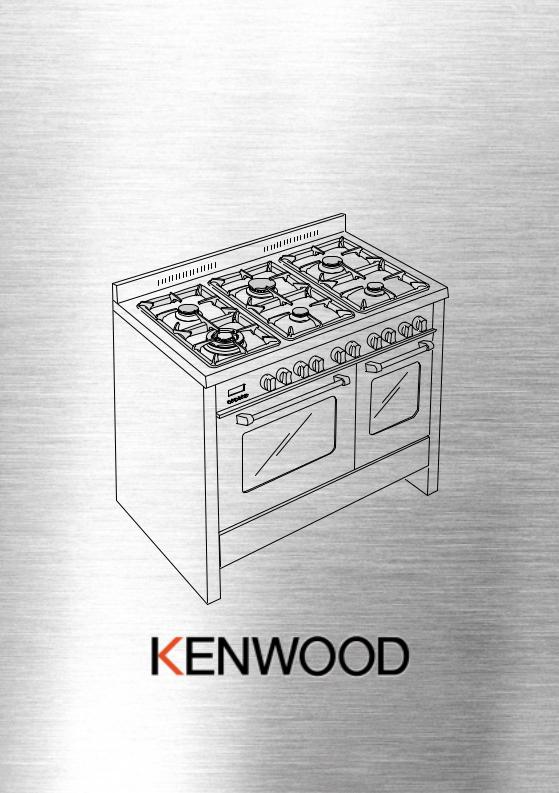
DUAL FUEL
DOUBLE OVEN COOKER
CK 740
Instructions for use - Installation advice
2
CONTENTS
Page Number Introduction . . . . . . . . . . . . . . . . . . . . . . . . . . . . . . . . . . . . . 4 Important Safeguards & Recommendations . . . . . . . . . . . . . . . . 5 Cooking Hob Key . . . . . . . . . . . . . . . . . . . . . . . . . . . . . . . . . 6 Control Panel . . . . . . . . . . . . . . . . . . . . . . . . . . . . . . . . . . . . 7 How to use the cooking hob . . . . . . . . . . . . . . . . . . . . . . . . . . 8 - 10 How to use the multi-function oven. . . . . . . . . . . . . . . . . . . . . . 11 - 16 How to use the conventional oven . . . . . . . . . . . . . . . . . . . . . . 17 - 22 How to use and set the electronic programmer . . . . . . . . . . . . . . 23 - 26 Cleaning & maintenance. . . . . . . . . . . . . . . . . . . . . . . . . . . . . 27 - 32
Advice For The Installer . . . . . . . . . . . . . . . . . . . . . . . . . . . . 33 Installation . . . . . . . . . . . . . . . . . . . . . . . . . . . . . . . . . . . . . . 34 - 38 Gas installation. . . . . . . . . . . . . . . . . . . . . . . . . . . . . . . . . . . 39 - 42 Electrical installation . . . . . . . . . . . . . . . . . . . . . . . . . . . . . . . 43 - 44
Service & Guarantee . . . . . . . . . . . . . . . . . . . . . . . . . . . . . . . 45
3
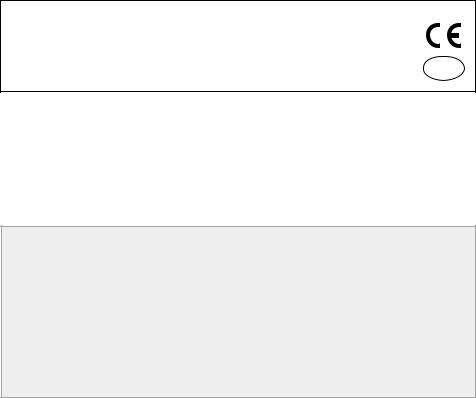
Dear Customer,
Thank you for purchasing a Kenwood Dual Fuel Double Oven Cooker
The safety precautions and recommendations in these instructions are for your own safety and that of others. They will also provide a means by which to make full use of the features offered by your appliance.
Please keep this booklet in a safe place. It may be useful in the future, either to yourself or to others in the event that doubts should arise relating to its operation.
This appliance must be used only for its intended purpose , that is for the domestic cooking of foodstuffs. Any other form of usage is to be considered as inappropriate and therefore dangerous.
The manufacturer declines all responsibility in the event of damage caused by improper, incorrect or illogical use of the appliance.
This cooker has been designed, constructed and marketed in compliance with:
- safety requirements of EEC Directive “Gas” 90/396; |
|
- safety requirements of EEC Directive “Low voltage” 73/23; |
|
- protection requirements of EEC Directive “EMC” 89/336; |
GB |
- requirements of EEC Directive 93/68. |
Read the instructions carefully before installing and using the appliance.
CAUTION: this appIiance must only be installed in a permanently ventilated room in compliance with the applicable regulations.
FIRST USE OF THE OVEN
Follow the instructions below:
–Furnish the interior of the oven by placing the wire racks as described in “Cleaning and maintenance”.
–Insert shelves and tray.
–Switch the empty oven on to max to eliminate grease from the heating elements.See pages 11 and 17.
–Let the oven cool down and clean the interior of the oven with a cloth soaked in water and neutral detergent, then dry carefully.
4
IMPORTANT SAFEGUARDS
AND RECOMMENDATIONS
After unpacking the appliance, check to ensure that it is not damaged and that the oven door closes correctly. If in doubt, do not use and consult your supplier or a professionally qualified technician.
Packing materials (i.e. plastic bags, polystyrene foam, nails, packing straps, etc.) should not be left around within easy reach of children, as these may cause serious injuries.
●ATTENTION: please peel plastic cover off both sides and front of the oven before use.
●Do not attempt to modify the technical characteristics of the appliance as this may cause danger to users.
●Do not carry out any cleaning or maintenance operations on the appliance without first disconnecting it from the electric power supply.
●If you should decide not to use this appliance any longer (or decide to substitute an older model), before disposing of it, it is recommended that it is made inoperative in an appropriate manner in accordance to health and environmental protection regulations, ensuring in particular that all potentially hazardous parts be made harmless, especially in relation to children who could play with unused appliances.
●After use, always ensure that the control knobs are in the off position.
●Do not allow young children or infirm persons to use the appliance without your supervision.
●During and after use of the cooker, certain parts will become very hot. Do not touch hot parts.
●Keep children away from the cooker when it is in use.
●Some appliances are supplied with a protective film on steel and aluminium parts. This film must be removed before using the appliance.
●Fire risk! Do not store flammable material in the oven or in the storage compartment.
●Make sure that electrical cords connecting other appliances in the proximity of the cooker cannot come into contact with the hob or become entrapped in the oven door.
●Do not line the oven walls with aluminium foil. Do not place baking trays or the drip tray on the base of the oven chamber.
●The manufacturer declines all liability for injury to persons or damage to property caused by incorrect or improper use of the appliance.
●The various components of the appliance are recyclable. Dispose of them in accordance with the regulations in force in your country. If the appliance is to be scrapped, remove the power cord.
●Always use oven gloves when removing the shelves and food trays from the oven whilst hot.
●Do not hang towels, dishcloths or other items on the cooker or its handle – as this could be a fire hazard.
●Clean the oven regularly and do not allow fat or oils to build up in the oven base or trays. Remove spillages as soon as they occur.
●Do not stand on the cooker or on the open oven door.
●Always stand back from the cooker when opening the oven door to allow steam and hot air to escape before removing the food.
●This appliance is for domestic use only.
5

1 - COOKING HOB
2 |
3 |
5 |
1 |
4 |
6 |
Fig. 1.1
COOKING HOB
1. |
Triple-ring burner (TR) |
3,50 kW |
2. |
Semi-rapid burner (SR) |
1,75 kW |
3. |
Rapid burner (R) |
3,00 kW |
4. |
Auxiliary burner (A) |
1,00 kW |
5. |
Semi-rapid burner (SR) |
1,75 kW |
6. |
Auxiliary burner (A) |
1,00 kW |
6
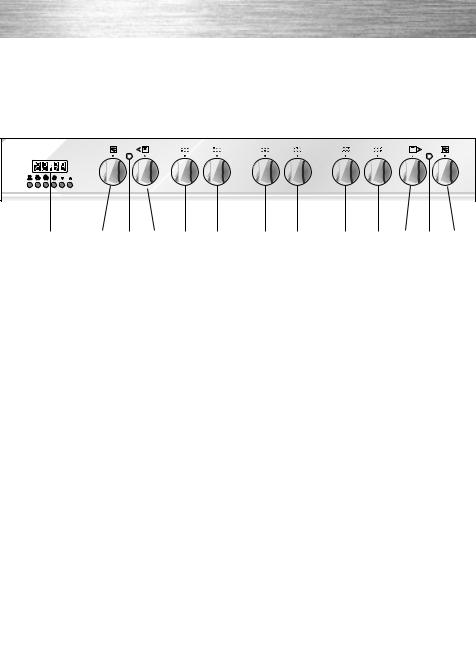
2 - CONTROL PANEL
Fig. 2.1
A |
|
|
|
|
|
|
|
|
|
|
|
|
U |
|
|
|
|
|
|
|
|
|
|
|
|
T |
|
|
|
|
|
|
|
|
|
|
|
|
O |
|
|
|
|
|
|
|
|
|
|
|
|
9 |
8 |
12 |
7 |
6 |
5 |
4 |
3 |
2 |
1 |
11 |
13 |
10 |
CONTROL PANEL - Controls description
1.Front right burner control knob
2.Rear right burner control knob
3.Rear central burner control knob
4.Front central burner control knob
5.Rear left burner control knob
6.Front left burner control knob
7.Multifunction main oven switch knob
8.Multifunction main oven temperature knob
9.Electronic programmer
10.Conventional oven temperature knob
11.Conventional oven switch knob
Pilot lamps:
12.Main oven temperature indicator light
13.Conventional oven temperature indicator light
7
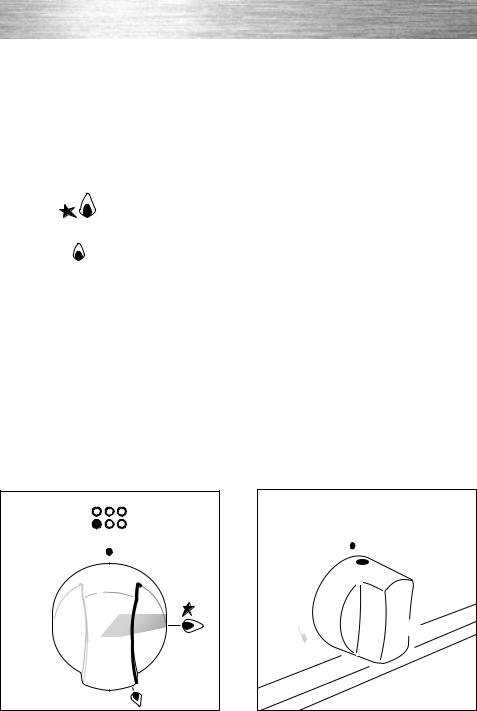
3 - USE OF COOKING HOB
GAS BURNERS
Each burner is controlled by a gas tap which opens and closes the gas supply. Line the control knob symbol up with the indicator on the control panel (fig. 3.1) to obtain:
– symbol |
● |
: off |
– symbol |
|
: full on |
(maximum rate)
– symbol |
: minimum rate |
To reduce the gas flow to minimum, rotate the knob anti-clockwise to point the indicator towards the small flame symbol.
The maximum setting permits rapid boiling of liquids, whereas the minimum setting allows slower warming of food or maintaining simmering conditions of liquids.
Other intermediate operating can be achieved by positioning the control knob indicator between the maximum and minimum setting, but not between the maximum and off positions.
LIGHTING THE BURNERS
To ignite the burner:
1)Lightly press and turn the knob anti-
clockwise and position the knob symbol 
 to the indicator printed on the control panel (fig. 3.2).
to the indicator printed on the control panel (fig. 3.2).
2)Press the knob to operate the electric ignition; or, in the case of a mains failure light the burner with a match or lighted taper.
3)Adjust the burner according to the setting required.
Fig. 3.1 |
Fig. 3.2 |
8
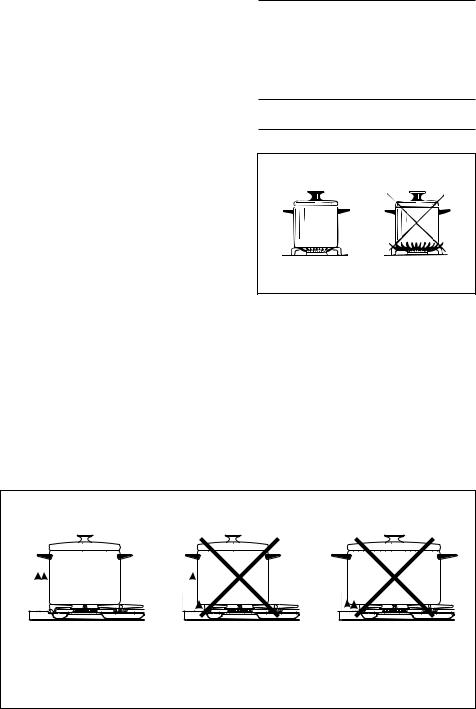
DEEP FAT FRYING
For safety purposes when deep fat frying, do not fill the pan more than one third full of oil.
DO NOT cover the pan with a lid and DO NOT leave the pan unattended.
In the unfortunate event of a fire, leave the pan where it is and turn off the control knobs.
Place a damp cloth or lid over the pan to smother the flames. Leave the pan to cool for at least 30minutes before moving the pan.
DO NOT USE WATER ON THE FIRE.
CHOICE OF THE BURNER
On the control panel, near each knob, there is a diagram that indicates which burner is controlled by that knob.
Select the burner that is most suitable for the diameter and capacity of the pan to be used.
As an indication, the burners and the pans must be used in the following way:
BURNERS |
POT DIAMETER |
Auxiliary |
12 - 14 cm |
|
|
Semi-rapid |
16 - 24 cm |
|
|
Rapid |
24 - 24 cm |
|
|
Triple-ring |
26 - 28 cm |
do not use pans with concave or convex bases (fig. 3.3)
Fig. 3.3
It is important that the base diameter of the pot is at least the same diameter as the burner ring to obtain an efficient heat transfer.
Always position pans centrally over the burners.
Adjust the size of the flame so that it does not lick up the side of the pan. Position pan handles so that they cannot be accidentally knocked.
|
|
|
|
|
|
|
|
|
|
|
|
|
|
|
|
|
|
|
|
|
|
|
|
|
|
|
|
|
|
|
|
|
|
|
|
|
|
|
|
|
|
|
|
|
|
|
|
|
|
|
|
|
|
|
|
|
|
|
|
|
|
|
|
|
|
|
|
|
|
|
|
|
|
|
|
|
|
|
|
|
|
|
|
|
|
|
|
|
|
|
|
|
|
|
|
|
|
|
|
|
|
|
|
|
|
|
|
|
|
|
|
|
|
|
|
|
|
|
|
|
|
|
|
|
|
|
|
|
|
|
|
|
|
|
|
|
|
|
|
|
|
|
|
|
|
|
|
|
|
|
|
|
|
|
|
|
|
|
|
|
|
|
|
|
|
|
|
|
|
|
|
|
|
|
|
|
|
|
|
|
|
|
|
|
|
|
|
|
|
|
|
|
|
|
|
|
|
|
|
AIR FLOW |
|
|
|
|
|
AIR FLOW |
|
|
|
|
AIR FLOW |
|
|
|
|
|||||||||
(cooling fan) |
|
|
|
|
|
(cooling fan) |
|
|
|
|
(cooling fan) |
|
|
|
|
|||||||||
CORRECT USE OF RAPID BURNER
Fig. 3.4
9
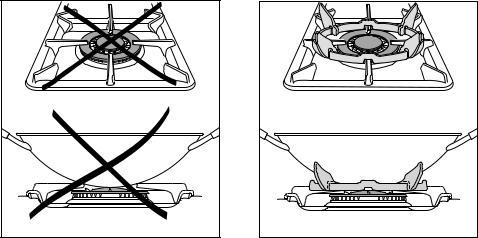
CORRECT USE OF TRIPLE-RING
BURNER (Fig. 3.5a - 3.5b)
Flat-bottomed pans should be placed directly onto the pan-support.
When using a WOK always place the supplied stand in position over the burner to maintain the correct operation of the triple-ring burner (Fig. 3.5a - 3.5b).
WRONG |
Fig. 3.5a |
CORRECT |
Fig. 3.5b |
10

4 - MULTI-FUNCTION MAIN OVEN
Attention: the oven door becomes very hot during operation.
Keep children away.
GENERAL FEATURES
The multifunction oven can be programed for 7 different functions to satisfy every cooking need.
The 7 positions are thermostatically controlled and are obtained by a combination of 4 heating elements which are:
– Bottom element |
2050 W |
– Top element |
1250 W |
– Grill element |
2200 W |
– Circular element |
2500 W |
NOTE:
Upon first use, it is advisable to operate the oven for 30 minutes in the position  and for another 30 minutes at maximum (temperature knob on position 225) in the positions
and for another 30 minutes at maximum (temperature knob on position 225) in the positions  and
and  , to eliminate possible traces of grease on the heating elements.
, to eliminate possible traces of grease on the heating elements.
Clean the oven and accessories with warm water and washing-up liquid.
WARNING:
The door is hot, use the handle.
OPERATING PRINCIPLES
Heating and cooking in the MULTIFUNCTION oven are obtained in the following ways:
a. by normal convection
The heat is produced by the upper and lower heating elements.
b. by forced convection
The circular heating element and fan constantly circulate heated air over the food in the oven for a more rapid and even cooking process. It is possible to cook several dishes simultaneously.
c. by semi-forced convection
The heat produced by the upper and lower heating elements is distributed throughout the oven by the fan.
d. by radiation
The heat is irradiated by the infra red grill element.
e. by radiation and ventilation
The irradiated heat from the infra red grill element is distributed throughout the oven by the fan.
f.by ventilation
The food is defrosted by using the fan only function without heat.
11
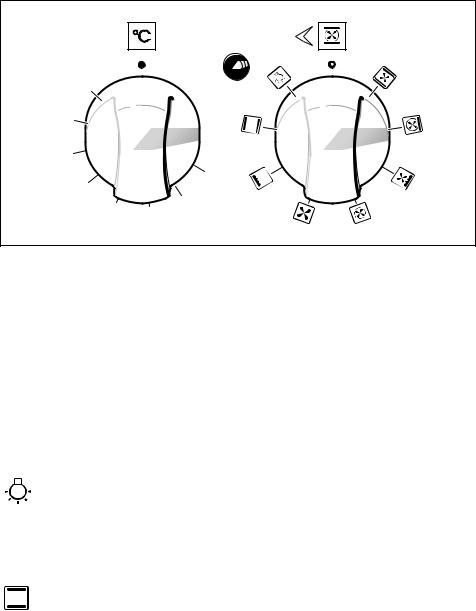
50
75 100
125
150
Fig. 4.1
250

225 200
175
Fig. 4.2
TEMPERATURE KNOB (fig. 4.2) |
FUNCTION SELECTOR KNOB (fig. 4.1) |
To turn on the heating elements of the oven, set the switch knob on the desired program and select the required temperature.
To set the temperature, line up the temperature knob indicator with the required temperature.
The elements will turn ON or OFF automatically according to the energy need which is determined by the thermostat.
Rotate the knob clockwise to set the oven for one of the following functions:
OVEN LIGHT
By setting the knob to this position, only the oven light comes on (15 W). The light remains on whilst any of the cooking modes are selected.
TRADITIONAL CONVECTION COOKING
The upper and lower heating elements are switched on. The heat is diffused by natural convection and the temperature must be set between 50° C and 225° C.
It is necessary to preheat the oven before adding the foods to be cooked.
Recommended for:
For foods which require the same cooking temperature both internally and externally, i. 12 e. roasts, spare ribs, meringue, etc.

GRILLING
The infra-red heating element is switched on. The heat is diffused by radiation.
Use with the oven door closed and the temperature knob between 50° and 225°C for a maximum of 15 minutes.
Note: It is recommended that you do not grill for longer than 30 minutes at any one time.
Attention: the oven door becomes very hot during operation. Keep children away.
For correct use see “USE OF THE GRILL”
Recommended for:
Intense grilling action for cooking with a broiler; browning, crisping, “au gratin”, toasting, etc.
DEFROSTING FROZEN FOODS
Only the oven fan is on. To be used with the temperature knob on “●” because the other positions will have no effect. The defrosting is done by simple ventilation without heat.
Recommended for:
To rapidly defrost frozen foods; 1 kilogram requires about one hour.
The defrosting times vary according to the quantity and type of foods to be defrosted.
HOT AIR COOKING
The circular element and the fan are on. The heat is diffused by forced convection and the temperature must be set between 50° and 225 °C.
It is not necessary to preheat the oven.
Recommended for:
For foods that must be well done on the outside and tender or rare on the inside, i. e. lasagna, lamb, roast beef, whole fish, etc.
13

VENTILATED GRILL COOKING
The infra-red ray grill and the fan are on. The heat is mainly diffused by radiation and the fan then distributes it throughout the oven. The temperature must be set between 50° and 175 °C for max 30 minutes. It is necessary to preheat the oven for about 5 minutes.
Use with the oven door closed.
Attention: the oven door becomes very hot during operation.
Keep children away.
For correct use see “GRILLING AND “AU GRATIN”.
Recommended for:
For grill cooking when a fast outside browning is necessary to keep the juices in, i. e. veal steak, steak, hamburger, etc.
THAWING AND WARMING UP
The upper element and the circular element connected in series, are switched on; also the fan is on. The heat is diffused by forced convection with the most heat being produced by the upper element.
The temperature must be set between 50° and 140 °C.
Recommended for:
To keep foods hot after cooking. To slowly heat already cooked foods.
CONVECTION COOKING WITH VENTILATION
The upper and lower heating elements and the fan turn on.
The heat coming from the top and bottom is diffused by forced convection. The temperature must be set between 50° and 225 °C.
Recommended for:
For foods of large volume and quantity which require the same internal and external degree of cooking; for ie: rolled roasts, turkey, legs, cakes, etc.
14
COOKING ADVICE
OVEN COOKING
Before introducing the food, preheat the oven to the desired temperature.
For a correct preheating operation, it is advisable to remove the tray from the oven and introduce it together with the food, when the oven has reached the desired temperature.
ROASTING
To obtain classical roasting, it is necessary to remember:
–that it is advisable to maintain a temperature between 180 and 200 °C.
–that the cooking time depends on the quantity and the type of foods.
SIMULTANEOUS COOKING OF DIFFERENT FOODS
The MULTI-FUNCTION oven set on position  and
and  gives simultaneous cooking of different foods.
gives simultaneous cooking of different foods.
Different foods such as fish, cake and meat can be cooked together without mixing the smells and flavours.
This is possible since the fats and vapors are oxidized while passing through the electrical element and therefore are not deposited onto the foods.
The only precautions to follow are:
–The cooking temperatures of the different foods must be as close to as possible, with a maximum difference of 20° - 25 °C.
–The introduction of the different dishes in the oven must be done at different times in relation to the cooking times of each one.
This type of cooking saves time and energy.
GRILLING AND “AU GRATIN”
Set the switch to position  .
.
Set the temperature knob to 175 °C and after having preheated the oven, simply place the food on the shelf.
Close the door and let the oven operate until grilling is complete.
Adding a few dabs of butter before the end of the cooking time gives the golden “au gratin” effect.
Note: It is recommended that you do not grill for longer than 30 minutes at any one time.
ATTENTION: the oven door becomes very hot during operation.
Keep children away.
USE OF THE GRILL
Preheat the oven for about 5 minutes. Introduce the food to be cooked, positioning the rack as close to the grill as possible.
The drip tray should be placed under the rack to catch the cooking juices and fats.
Grill with the oven door closed.
Do not grill for longer than 30 minutes at any one time.
CAUTION: the oven door becomes very hot during operation. Keep children well out of reach.
15
